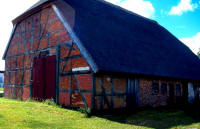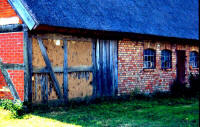 How can a home in Germany last 300 years or more? Easy. They
literally pound the stuffing out of it on a regular basis. How can a home in Germany last 300 years or more? Easy. They
literally pound the stuffing out of it on a regular basis.
When a house that we would call "half-timbered" or "fachwerke,"
as the Germans say reaches a certain age, say about 100-120 years,
the Germans don't do as we would do (in fact we would do it much,
much earlier) and just bulldoze the thing down to make room for a
newer, "improved" version. Instead, they painstakingly resurrect the
house in a process that can take a month or so, but can prolong the
life of the house another 100 years. Then the next generation has to
worry about the next renovation.
 Renovating a fachwerke house works like this: The owners move
out, taking all of their belongings with them. Most people live with
relatives or in an apartment while their house is being rebuilt.
Once all the fixtures and wiring has been carefully removed, the
walls come tumbling down. Jackhammers punch out all the brick,
plaster, straw, sticks and other "filling" that makes this house
solid. The only parts of the house that are left once they're done
with this phase of the rebuilding process are the original heavy
timbers and the roof. Renovating a fachwerke house works like this: The owners move
out, taking all of their belongings with them. Most people live with
relatives or in an apartment while their house is being rebuilt.
Once all the fixtures and wiring has been carefully removed, the
walls come tumbling down. Jackhammers punch out all the brick,
plaster, straw, sticks and other "filling" that makes this house
solid. The only parts of the house that are left once they're done
with this phase of the rebuilding process are the original heavy
timbers and the roof.
 The house is left a skeleton, a bare ghost of what it was before.
Where straw, mud or even sticks might have held this house together
for the last 120 years, now workers come with bricks, concrete and plaster, refilling all the spaces in-between the timbers
until the house is whole again. The floors are reinstalled, The house is left a skeleton, a bare ghost of what it was before.
Where straw, mud or even sticks might have held this house together
for the last 120 years, now workers come with bricks, concrete and plaster, refilling all the spaces in-between the timbers
until the house is whole again. The floors are reinstalled,
 doors
re-hung, windows placed back into the gaping holes in the walls.
Flower boxes are put back onto the window sills, the lights come
back on and this house is once again a home. Changed, but not
altered. Renewed but not moved. Standing crooked or straight, this
house is strong again and will last beyond the time when the owners
have passed into the next world for their own hopeful rebirth. doors
re-hung, windows placed back into the gaping holes in the walls.
Flower boxes are put back onto the window sills, the lights come
back on and this house is once again a home. Changed, but not
altered. Renewed but not moved. Standing crooked or straight, this
house is strong again and will last beyond the time when the owners
have passed into the next world for their own hopeful rebirth.
It's a process that inspires one to believe that these little
villages and towns will look the same in the year 2099 as they did
in the year 1999, or the year 1899, or the year 1799.
|